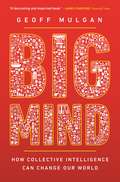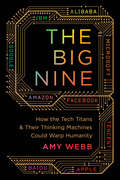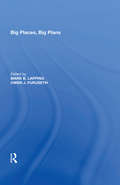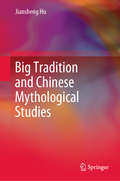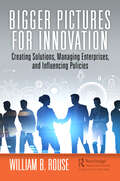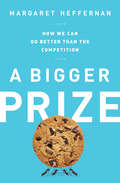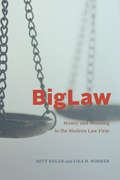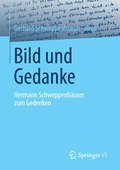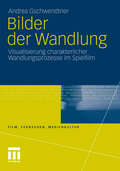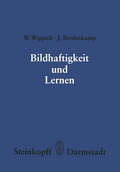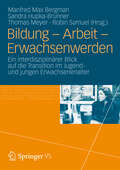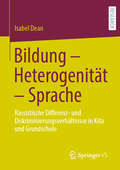- Table View
- List View
Big Mind: How Collective Intelligence Can Change Our World
by Geoff MulganA new field of collective intelligence has emerged in the last few years, prompted by a wave of digital technologies that make it possible for organizations and societies to think at large scale. This “bigger mind”—human and machine capabilities working together—has the potential to solve the great challenges of our time. So why do smart technologies not automatically lead to smart results? Gathering insights from diverse fields, including philosophy, computer science, and biology, Big Mind reveals how collective intelligence can guide corporations, governments, universities, and societies to make the most of human brains and digital technologies.Geoff Mulgan explores how collective intelligence has to be consciously organized and orchestrated in order to harness its powers. He looks at recent experiments mobilizing millions of people to solve problems, and at groundbreaking technology like Google Maps and Dove satellites. He also considers why organizations full of smart people and machines can make foolish mistakes—from investment banks losing billions to intelligence agencies misjudging geopolitical events—and shows how to avoid them.Highlighting differences between environments that stimulate intelligence and those that blunt it, Mulgan shows how human and machine intelligence could solve challenges in business, climate change, democracy, and public health. But for that to happen we’ll need radically new professions, institutions, and ways of thinking.Informed by the latest work on data, web platforms, and artificial intelligence, Big Mind shows how collective intelligence could help us survive and thrive.
The Big Nine: How the Tech Titans and Their Thinking Machines Could Warp Humanity
by Amy WebbA call-to-arms about the broken nature of artificial intelligence, and the powerful corporations that are turning the human-machine relationship on its head.We like to think that we are in control of the future of "artificial" intelligence. The reality, though, is that we--the everyday people whose data powers AI--aren't actually in control of anything. When, for example, we speak with Alexa, we contribute that data to a system we can't see and have no input into--one largely free from regulation or oversight. The big nine corporations--Amazon, Google, Facebook, Tencent, Baidu, Alibaba, Microsoft, IBM and Apple--are the new gods of AI and are short-changing our futures to reap immediate financial gain. In this book, Amy Webb reveals the pervasive, invisible ways in which the foundations of AI--the people working on the system, their motivations, the technology itself--is broken. Within our lifetimes, AI will, by design, begin to behave unpredictably, thinking and acting in ways which defy human logic. The big nine corporations may be inadvertently building and enabling vast arrays of intelligent systems that don't share our motivations, desires, or hopes for the future of humanity.Much more than a passionate, human-centered call-to-arms, this book delivers a strategy for changing course, and provides a path for liberating us from algorithmic decision-makers and powerful corporations.
Big Places, Big Plans
by Mark B. LappingWith origins in the late 1960s, a 'quiet revolution' in land use planning and control has taken hold across North America. First seen as a manifestation of the environmental movement, the revolution prompted governments at several levels to attempt to protect critical areas and vulnerable natural resources. Many of the most dramatic and far-reaching shifts in planning regimes have occurred in large-scale, environmentally unique or sensitive regions. It is these big places, looming large in the American and Canadian psyches, that are the focus of this edited volume. Each of the chapters reflects on the contemporary challenge of environmental and land use planning. Ten leading distinguished scholars here provide thoughtful analyses and critical insights into the processes and contexts shaping the innovative planning and policy schemes in seven regional landscapes.
Big Places, Big Plans
by Mark B. LappingWith origins in the late 1960s, a 'quiet revolution' in land use planning and control has taken hold across North America. First seen as a manifestation of the environmental movement, the revolution prompted governments at several levels to attempt to protect critical areas and vulnerable natural resources. Many of the most dramatic and far-reaching shifts in planning regimes have occurred in large-scale, environmentally unique or sensitive regions. It is these big places, looming large in the American and Canadian psyches, that are the focus of this edited volume. Each of the chapters reflects on the contemporary challenge of environmental and land use planning. Ten leading distinguished scholars here provide thoughtful analyses and critical insights into the processes and contexts shaping the innovative planning and policy schemes in seven regional landscapes.
Big Science Transformed: Science, Politics and Organization in Europe and the United States
by Olof HallonstenThis book analyses the emergence of a transformed Big Science in Europe and the United States, using both historical and sociological perspectives. It shows how technology-intensive natural sciences grew to a prominent position in Western societies during the post-World War II era, and how their development cohered with both technological and social developments. At the helm of post-war science are large-scale projects, primarily in physics, which receive substantial funds from the public purse. Big Science Transformed shows how these projects, popularly called 'Big Science', have become symbols of progress. It analyses changes to the political and sociological frameworks surrounding publicly-funding science, and their impact on a number of new accelerator and reactor-based facilities that have come to prominence in materials science and the life sciences. Interdisciplinary in scope, this book will be of great interest to historians, sociologists and philosophers of science.
The Big Society Debate: A New Agenda for Social Policy? (PDF)
by Armine Ishkanian Simon SzreterThe expert contributors to this detailed yet concise book collectively raise questions about the novelty of the Big Society Agenda, its ideological underpinnings, and challenges it poses for policymakers and practitioners. The book is divided into two sections, history and policy, which together provide readers with a historically grounded, internationally informed, and multidisciplinary analysis of the Big Society policies. The introduction and conclusion tie the strands together, providing a coherent analysis of the key issues in both sections. Various chapters in this study examine the limitations and consider the challenges involved in translating the ideas of the Big Society agenda into practice. By drawing on international examples, from developed and developing countries in order to analyse and discuss Big Society policies, this book will prove invaluable for students, academics and policymakers.
The Big Time: How the 1970s Transformed Sports in America
by Michael MacCambridge&“Indispensable history.&” –Sally Jenkins, bestselling author of The Right Call A captivating chronicle of the pivotal decade in American sports, when the games invaded prime time, and sports moved from the margins to the mainstream of American culture. Every decade brings change, but as Michael MacCambridge chronicles in THE BIG TIME, no decade in American sports history featured such convulsive cultural shifts as the 1970s. So many things happened during the decade—the move of sports into prime-time television, the beginning of athletes&’ gaining a sense of autonomy for their own careers, integration becoming—at least within sports—more of the rule than the exception, and the social revolution that brought females more decisively into sports, as athletes, coaches, executives, and spectators. More than politicians, musicians or actors, the decade in America was defined by its most exemplary athletes. The sweeping changes in the decade could be seen in the collective experience of Billie Jean King and Muhammad Ali, Henry Aaron and Julius Erving, Kareem Abdul-Jabbar and Joe Greene, Jack Nicklaus and Chris Evert, among others, who redefined the role of athletes and athletics in American culture. The Seventies witnessed the emergence of spectator sports as an ever-expanding mainstream phenomenon, as well as dramatic changes in the way athletes were paid, portrayed, and packaged. In tracing the epic narrative of how American sports was transformed in the Seventies, a larger story emerges: of how America itself changed, and how spectator sports moved decisively on a trajectory toward what it has become today, the last truly &“big tent&” in American culture.
Big Tradition and Chinese Mythological Studies
by Jiansheng HuThis book focuses on reinterpreting mythical China from the perspective of the cultural theory of big tradition. It is divided into two parts: the first explains the theoretical development and features of the Chinese version of big tradition, identifying the differences between the Eastern and Western cultural traditions (big tradition and great tradition). The second part then reinterprets the core values and mythical ideas of Chinese civilization and traditional culture from the perspective of big tradition.Moving beyond the small tradition of text centrism and using new methods and materials, the book reveals the original meaning and the cultural coding function of big tradition during the preliterate period. Drawing on integrated evidence from literature handed down from ancient times, oral and intangible cultural heritage, tangible culture, cross-cultures, image culture and unearthed documents, the book interprets Chinese cultural traditions and spiritual values from local, archaeological, experiential and survival perspectives, to help readers better understand the mythical codes and genes of early Chinese culture.
Bigger Pictures for Innovation: Creating Solutions, Managing Enterprises, and Influencing Policies
by William B. RouseThis book comprises a set of stories about being an engineer for many decades and the lessons the author learned from research and practice. These lessons focus on people and organizations, often enabled by technology. The settings range from airplanes, power plants, and communication networks to ecosystems that enable education, healthcare, and transportation. All of these settings are laced with behavioral and social phenomena that need to be understood and influenced. The author’s work in these domains has often led to the question: "Well, why does it work like that?" He invariably sought to understand the bigger picture to find the sources of requirements, constraints, norms, and values. He wanted to understand what could be changed, albeit often with much effort to overcome resistance. He found that higher levels of an ecosystem often provide the resources and dictate the constraints imposed on lower levels. These prescriptions are not just commands. They also reflect values and cultural norms. Thus, the answers to the question were not just technical and economic. Often, the answers reflected eons of social and political priorities. The endeavors related in the book frequently involved addressing emerging realities rather than just the status quo. This book is an ongoing discovery of these bigger pictures. The stories and the lessons related in this book provide useful perspectives on change. The understanding of people and organizations that emerges from these lessons can help to enable transformative change. Fundamental change is an intensely human-centric endeavor, not just for the people and organizations aspiring to change, but also for the people helping them. You will meet many of these people in this book as the stories unfold. The genesis of this book originated in a decision made early in the author’s career. He had developed a habit of asking at the end of each day, "What did I really accomplish today?" This was sometimes frustrating as he was not sure the day had yielded any significant accomplishments. One day it dawned on him that this was the wrong question – He needed to ask, "What did I learn today?" It is always possible to learn, most recently about public health and climate change. In planning this book, the author first thought in terms of accomplishments such as projects conducted, systems built, and articles and books published. He could not imagine this being interesting to readers. Then, it struck him – It is much more interesting to report on what he learned about people and organizations, including how he helped them accomplish their goals. This is a book of stories about how these lessons emerged. In planning this book, the author first thought in terms of accomplishments such as projects conducted, systems built, and articles and books published. He could not imagine this being interesting to readers. Then, it struck him – It is much more interesting to report on what he learned about people and organizations, including how he helped them accomplish their goals. This is a book of stories about how these lessons emerged.
Bigger Pictures for Innovation: Creating Solutions, Managing Enterprises, and Influencing Policies
by William B. RouseThis book comprises a set of stories about being an engineer for many decades and the lessons the author learned from research and practice. These lessons focus on people and organizations, often enabled by technology. The settings range from airplanes, power plants, and communication networks to ecosystems that enable education, healthcare, and transportation. All of these settings are laced with behavioral and social phenomena that need to be understood and influenced. The author’s work in these domains has often led to the question: "Well, why does it work like that?" He invariably sought to understand the bigger picture to find the sources of requirements, constraints, norms, and values. He wanted to understand what could be changed, albeit often with much effort to overcome resistance. He found that higher levels of an ecosystem often provide the resources and dictate the constraints imposed on lower levels. These prescriptions are not just commands. They also reflect values and cultural norms. Thus, the answers to the question were not just technical and economic. Often, the answers reflected eons of social and political priorities. The endeavors related in the book frequently involved addressing emerging realities rather than just the status quo. This book is an ongoing discovery of these bigger pictures. The stories and the lessons related in this book provide useful perspectives on change. The understanding of people and organizations that emerges from these lessons can help to enable transformative change. Fundamental change is an intensely human-centric endeavor, not just for the people and organizations aspiring to change, but also for the people helping them. You will meet many of these people in this book as the stories unfold. The genesis of this book originated in a decision made early in the author’s career. He had developed a habit of asking at the end of each day, "What did I really accomplish today?" This was sometimes frustrating as he was not sure the day had yielded any significant accomplishments. One day it dawned on him that this was the wrong question – He needed to ask, "What did I learn today?" It is always possible to learn, most recently about public health and climate change. In planning this book, the author first thought in terms of accomplishments such as projects conducted, systems built, and articles and books published. He could not imagine this being interesting to readers. Then, it struck him – It is much more interesting to report on what he learned about people and organizations, including how he helped them accomplish their goals. This is a book of stories about how these lessons emerged. In planning this book, the author first thought in terms of accomplishments such as projects conducted, systems built, and articles and books published. He could not imagine this being interesting to readers. Then, it struck him – It is much more interesting to report on what he learned about people and organizations, including how he helped them accomplish their goals. This is a book of stories about how these lessons emerged.
A Bigger Prize: How We Can Do Better than the Competition
by Margaret HeffernanGet into the best schools. Land your next big promotion. Dress for success. Run faster. Play tougher. Work harder. Keep score. And whatever you do-make sure you win.Competition runs through every aspect of our lives today. From the cubicle to the race track, in business and love, religion and science, what matters now is to be the biggest, fastest, meanest, toughest, richest.The upshot of all these contests? As Margaret Heffernan shows in this eye-opening book, competition regularly backfires, producing an explosion of cheating, corruption, inequality, and risk. The demolition derby of modern life has damaged our ability to work together.But it doesn't have to be this way. CEOs, scientists, engineers, investors, and inventors around the world are pioneering better ways to create great products, build enduring businesses, and grow relationships. Their secret? Generosity. Trust. Time. Theater. From the cranberry bogs of Massachusetts to the classrooms of Singapore and Finland, from tiny start-ups to global engineering firms and beloved American organizations-like Ocean Spray, Eileen Fisher, Gore, and Boston Scientific-Heffernan discovers ways of living and working that foster creativity, spark innovation, reinforce our social fabric, and feel so much better than winning.
The Biggest Game in Town
by Al AlvarezSince its first publication twenty years ago, The Biggest Game in Town has become a sought-after cult classic. Acclaimed writer and critic Al Alvarez delves into the murky and compelling world of high-stakes Vegas poker, where 'the next best thing to playing and winning is playing and losing'. Uncovering an exotic underground rich in ambiance and eccentricity, The Biggest Game in Town is a real one of a kind, deftly capturing the skewed psyches and peculiar rites of professional poker players who descend every year for the World Series of Poker. It's a world that seems almost too surprising and bizarre to be true. 'A cool, precise, sharply witty, vivid evocation of a place and people, their appearances, behaviour and speech..Mr Alvarez is a shrewd analyst of the psychology of gamblers and a cleverly selective recorder of their bizarre talk with which, directly and indirectly, they reveal their secure grasp of unreality and their insane courage' Sunday Telegraph 'It will have most readers sitting on the edge of their seats' Sunday Times 'A new classic on gambling...it's quite brilliant' Time Out 'This is a magnificent book. Beyond the straights and full houses, Alvarez has written about people who are extremely good at what they do, and about America' San Francisco Chronicle
BigLaw: Money and Meaning in the Modern Law Firm (Chicago Series in Law and Society)
by Mitt Regan Lisa H. RohrerThe Great Recession intensified large law firms’ emphasis on financial performance, leading to claims that lawyers in these firms were now guided by business rather than professional values. Based on interviews with more than 250 partners in large firms, Mitt Regan and Lisa H. Rohrer suggest that the reality is much more complex. It is true that large firm hiring, promotion, compensation, and termination policies are more influenced by business considerations than ever before and that firms actively recruit profitable partners from other firms to replace those they regard as unproductive. At the same time, law firm partners continue to seek the non-financial rewards of being members of a distinct profession and are sensitive to whether their firms are committed to providing them. Regan and Rohrer argue that modern firms responding effectively to business demands while credibly affirming the importance of non-financial professional values can create strong cultures that enhance their ability to weather the storms of the modern legal market.
BigLaw: Money and Meaning in the Modern Law Firm (Chicago Series in Law and Society)
by Mitt Regan Lisa H. RohrerThe Great Recession intensified large law firms’ emphasis on financial performance, leading to claims that lawyers in these firms were now guided by business rather than professional values. Based on interviews with more than 250 partners in large firms, Mitt Regan and Lisa H. Rohrer suggest that the reality is much more complex. It is true that large firm hiring, promotion, compensation, and termination policies are more influenced by business considerations than ever before and that firms actively recruit profitable partners from other firms to replace those they regard as unproductive. At the same time, law firm partners continue to seek the non-financial rewards of being members of a distinct profession and are sensitive to whether their firms are committed to providing them. Regan and Rohrer argue that modern firms responding effectively to business demands while credibly affirming the importance of non-financial professional values can create strong cultures that enhance their ability to weather the storms of the modern legal market.
Bild und Gedanke: Hermann Schweppenhäuser zum Gedenken
by Gerhard SchweppenhäuserDie Beiträge des Bandes loten Tiefe und Wirkung der Schriften des Philosophen Hermann Schweppenhäuser aus. Schweppenhäuser (1928-2015) gehörte zum engsten Kreis um Adorno und Horkheimer, führte die kritische Theorie als dialektische Philosophie weiter und verband sie mit dem Denkstil Walter Benjamins, dessen Schriften er mit Rolf Tiedemann herausgegeben hat. Schweppenhäuser hinterlässt ein vielfältiges philosophisches und schriftstellerisches Werk: Abhandlungen, Essays, Aphorismen und Handbuchartikel, lyrische Formen und kurze Prosa. Die Autorinnen und Autoren geben in diesem Gedenkbuch Resonanz davon, wie sich ihnen die Vielfalt von Schweppenhäusers Denken und Schaffen gezeigt hat; teils in biografischer, teils in thematischer Hinsicht. Dazu kommen unveröffentlichte Texte aus dem Nachlass.„In der Zeitrechnung der kritischen Theorie endete mit Schweppenhäusers Tod eine Ära.“ Christoph Türcke
Bild und Habitus: Sinnbildungsprozesse bei der Rezeption von Fotografien
by Burkard MichelBilder zeichnen sich durch eine eigentümliche Kombination von ikonischer Exaktheit und semantischer Unbestimmtheit aus: Obwohl auf den ersten Blick zu sehen ist, was auf einem gegenständlichen Bild ‚drauf' ist, bleibt sein Sinn oftmals offen und vieldeutig. Erst in der Interaktion mit den Rezipierenden bildet sich der Sinn - und verändert sich mit ihnen. Wie die sinnerzeugende Interaktion abläuft, untersucht Burkard Michel unter Bezug auf die Habitustheorie Pierre Bourdieus und macht sie damit für die Medienrezeptionsforschung fruchtbar. Rezeptionsprozesse auf Basis des milieuspezifischen Habitus sind demnach nicht als rationalistische Akte ‚reiner Erkenntnis', sondern als praktisches Handeln zu begreifen, das sich "jenseits von Bewusstsein und diskursivem Denken" (Bourdieu) vollzieht. Um diese präreflexive Sinnebene bei der Rezeption von Bildern empirisch zu rekonstruieren, wendet der Autor die Dokumentarische Methode nach Ralf Bohnsack in Verbindung mit dem Gruppendiskussionsverfahren exemplarisch an und entwickelt so die Umrisse einer "praxeologischen Rezeptionsforschung".
Bilder der Wandlung: Visualisierung charakterlicher Wandlungsprozesse im Spielfilm (Film, Fernsehen, Medienkultur)
by Andrea GschwendtnerIn diesem Band werden acht Spielfilme untersucht, deren Hauptfiguren in kurzer Zeit, d.h. über wenige Wochen bis zu eineinhalb Jahren, einen grundlegenden charakterlichen Wandlungsprozess erleben. Es wird eine Palette typologischer, filmischer Gestaltungsmittel herausgearbeitet, die als Visualisierungsmuster für Prozesse des Scheiterns und der Reifung eingesetzt werden. Spezifische Gestaltungsweisen von z.B. Kostüm, Schauplätzen und Blickweisen der Kamera, aber auch in der narrativen Konstruktion, der Wissensgabe und Zeitdarstellung zählen zu den typologisierbaren Visualisierungselementen für charakterliche Wandlungsprozesse. Die zentralen Erkenntnisse dieser Studie eröffnen innovative Perspektiven auf filmische Gestaltung - sowohl für die Filmpraxis (Drehbuchautoren, Regisseure, Kameraleute, Szenografen, Produzenten u.a.) als auch für die Film- und Medienwissenschaft.
Bilder in historischen Diskursen (Interdisziplinäre Diskursforschung)
by Franz X. Eder Oliver Kühschelm Christina LinsbothBislang wurden in der historischen Diskursanalyse Fragen zur Funktion von Bildern in Diskursen noch wenig berücksichtigt. Die Beiträge des vorliegenden Bandes nehmen sich dieser Thematik an und zeigen, dass auch Bilder die Möglichkeitsbedingungen des Sag- und Denkbaren bestimmen. Sie widmen sich Zeichnungen, Skizzen, Drucken, Gemälden, Fotos und Diagrammen und analysieren deren mannigfältige Interaktionen mit (verbalen) Texten. Die Autoren und Autorinnen bewegen sich im weiten Rahmen der historischen Diskursanalyse, verfolgen aber auch semiologisch und praxeologisch orientierte Perspektiven. Vielfach arbeiten sie einer Mediengeschichte der Bild-Text-Kommunikation zu. Sie zeigen exemplarisch, was eine um Bilder bemühte historische Diskursanalyse leisten kann – für die Diskursanalyse selbst wie für ein Verständnis der Kommunikation mit Bildern. Gegenüber Wissenschaften, die auf Praktiken der aktuellen Bildverwendung fokussieren, kann der Blick in die Vergangenheit die Kontingenz von Regelmäßigkeiten aufzeigen und so Kurzschlüsse auf anthropologische Konstanten unterlaufen.
Bilder von jungen Menschen aus der Sicht Älterer: Eine rekonstruktive Studie am Beispiel eines innerstädtischen Wohnquartiers in Nordrhein-Westfalen
by Andreas BergholzDieses Buch widmet sich einer Forschungslücke im Bereich der Generationenforschung. Anhand eines rekonstruktiven Zugangs legt Andreas Bergholz unterschiedliche Perspektiven von älteren Menschen auf Jüngere in ihrer Komplexität und Vielfalt jenseits von Stereotypen offen. Am Beispiel eines innerstädtischen Wohnquartiers bringt der Autor diese Erkenntnisse mit der Bedeutung des unmittelbaren Wohnumfeldes für die Aneignung und Aktualisierung von Perspektiven auf junge Menschen in Verbindung und legt dar, welche Rolle das Quartier als intergenerationaler Begegnungsort spielen kann.
Bildhaftigkeit und Lernen (Wissenschaftliche Forschungsberichte #78)
by W. Wippich J. BredenkampIn der vorliegenden Monographie stellen wir die Ergebnisse eines Forschungsprojektes dar, das von der DFG in der Zeit von April 1974 bis Oktober 1975 finanziell gefördert wurde. Konzipiert wurde das Forschungsprogramm 1973; die Auswertungen wurden 1977 abgeschlossen. Der frühe Beginn hat es mit sich gebracht, daß neuere Entwick lungen der "imagery"-Forschung bei der Planung der Untersuchungen nicht berück sichtigt werden konnten. Wir haben uns jedoch bemüht, diese Tendenzen im ersten Kapitel und in der abschließenden Diskussion darzustellen. Im einzelnen gliedert sich die vorliegende Schrift wie folgt: Kapitel 1 informiert umfassend - wie wir hoffen - über den Stand der "imagery"-Forschung in der Gedächtnispsychologie bis 1977 und bereitet den empirischen Teil vor. Wir haben vier Problembereiche herausgearbeitet, die uns für die Auseinandersetzung mit dem "imagery"-Konstrukt als wesentlich erschienen. Diese Problemkreise lassen sich durch vier Fragen kennzeichnen: 1. Fördern nonverbale Ver arbeitungsprozesse das Behalten sprachlichen Lernmaterials über längere Zeiträume? 2. Welcher Stellenwert kommt dem "imagery"-Konstrukt in Speicherkonzeptionen des Gedächtnisses zu? 3. Zeichnen sich imaginale Verarbeitungsprozesse im Unterschied zu sprachlichen durch bestimmte Charakteristika aus? 4. Welche Rolle kommt der Bild haftigkeit beim Satz- und Textlernen zu? In Kapitel 2 werden die Ergebnisse von sieben Experimenten erörtert, die diesen Fragen gewidmet sind. Das letzte Kapitel diskutiert die Resultate im Zusammenhang und unter Bezug auf die ausführlich in Kapitel 1 geschil derte Theorie Paivias. Da unser Bericht praktisch relevante Bezüge aufweist, hoffen wir, nicht nur den Psychologen, sondern auch den Pädagogen ansprechen zu können.
Bildhaftigkeit und Organisation: Untersuchungen zu einer differenzierten Organisationshyothese (Reihe 1: Grundlagenforschung und Grundlegende Methodik)
by W. WippichWissenschaftliche Forschungsberichte,Reihe I,Abt.C,Band 80
Bildsprache und Medienbilder: Die visuelle Darstellungslogik von Nachrichtenmagazinen
by Claudia Maria WolfDie zunehmend bedeutsame Position, die professionelle visuelle Gestalter im redaktionellen Alltag einnehmen, steht in auffallendem Gegensatz zur geringen Aufmerksamkeit, die ihnen seitens der Medien- und Kommunikationsforschung bisher zukommt. Dabei ist ihnen auf Grund ihres Wissens über die Funktionsweise der "Sprache der Bilder" - ein Wissen, das sie zur zielgerichteten Kommunikation mit den Medienrezipienten nutzen - eine ähnlich wesentliche Rolle im Rahmen der Nachrichtenvermittlung einzuräumen wie ihren Kollegen vom Wort-Journalismus. Von dieser These ausgehend, wendet sich Claudia Maria Wolf den Strategien und Codes zu, auf denen die visuelle Kommunikation im Printmedienbereich basiert. Mittels einer umfassenden theoretischen und empirischen Untersuchung werden anhand des Forschungsgegenstandes "politisches Nachrichtenmagazin" neue Wege zu einem adäquaten Verständnis der "Sprache der Medienbilder" aufgezeigt.
Bildung – Arbeit – Erwachsenwerden: Ein interdisziplinärer Blick auf die Transition im Jugend und jungen Erwachsenenalter
by Manfred Max Bergman Sandra Hupka-Brunner Thomas Meyer Robin SamuelDer Übergang von der Schule ins Erwachsenen- und Erwerbsleben ist eine entscheidende und kritische Lebensphase. Vieles deutet darauf hin, dass diese Transitionen in modernen Gesellschaften länger, anforderungsreicher, unübersichtlicher und risikoreicher geworden sind. Der vorliegende Band beleuchtet diese Transitionen aus Sicht der Ökonomie, Pädagogik, Psychologie und Soziologie. Dazu werden disziplinäre und interdisziplinäre Beiträge sowie aktuelle empirische Zugänge präsentiert, die die biografische Phase von der Grundbildung bis ins Erwerbsleben abdecken.
Bildung – ein Menschenrecht: GLOBArt Academy 2006 (GLOBArt)
„Wissen wird der Rohstoff des 21. Jahrhunderts sein.“ Sätze wie dieser v- deutlichen, dass uns das Thema Bildung und Wissen vor neue Herausfor- rungen stellt. Globaler Wettbewerb, sozialer Wandel, technische Revolution, neue Energiekonzepte fordern ständig neue Denk- und Lösungsansätze. B- dung und Ausbildung entscheiden darüber, ob künftige Generationen zum - tiven Gestalter oder zum passiven Spielball der der Welt von morgen werden. Wie können wir mitgestalten, nicht zuletzt im internationalen Wettbewerb? Wie können wir möglichst vielen jungen Menschen das Rüstzeug vermitteln, ihre Fähigkeiten und ihr geistiges Potential für sich und die Gesellschaft op- mal auszubilden? Bildung und Wissenschaft scheinen zur sozialen Frage des 21. Jahrhunderts zu werden. Daher müssen wir heute darüber entscheiden, wie die Bildun- politik von morgen aussieht. Bildung darf nicht darauf beschränkt werden, junge Menschen auf den Beruf und für den Arbeitsmarkt vorzubereiten. - gabungen und Talente aller sind erfolgreich zu fordern und zu fördern, um es Menschen zu ermöglichen, ihre Welt selbstbestimmt und verantwortlich zu gestalten.
Bildung – Heterogenität – Sprache: Rassistische Differenz- und Diskriminierungsverhältnisse in Kita und Grundschule
by Isabel DeanIm Unterschied zum Sekundarschulbereich gelten Kita und Grundschule zumeist als Bildungsabschnitte, in denen alle Kinder gemeinsam, also unabhängig von Herkunft und diverser sozialer und natio-ethno-kulturell codierter Hintergründe zusammen lernen. Jedoch ereignen sich auch im Übergang von der Kita zur Grundschule diverse rassistische und mehrfachdiskriminierende Dynamiken. Die vorliegende Studie zeichnet verschiedene dieser potenziell diskriminierenden und segregierenden „neuralgischen Punkte“ nach, die sich auf der Ebene verschiedener Akteur*innengruppen, Diskurse, Konfliktlinien und Praktiken vollziehen.
